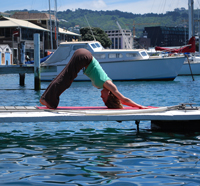By Kara-Leah Grant, author of Forty Days of Yoga
If you prefer to video to reading, check out the ten minute video at the end of this article.
The whole premise of Forty Days of Yoga is built on the idea that by letting go of our fixed ideas of what a yoga practice is we can find a practice that works for our life and our lifestyle.
It’s about being kind and compassionate to yourself and working with what you needs.
However, the flip side of this approach is that it can be easy to avoid the more difficult aspects of practice and indulge in what feels good all the time.
It can also mean that you have no set focus for your practice and the dipping into this and that doesn’t allow you to deeply learn anything.
Using an Anchor deals to both these issues. What’s an Anchor?
An anchor is an aspect of practice that you decide to do every single day of your Forty Days, no matter what. That aspect of practice stays the same, even when everything else shifts around.
You might practice at all different times during the day and night, but you always anchor your practice with the same thing.
You might practice at home, at work, outside and while travelling, but you always anchor your practice with the same thing.
Practically speaking, an anchor provides a container for our practice. Think of water, without a container of some kind of spills out everywhere and can easily evaporate. With a container – like a cup or a bowl, the water can be held and used well.
An anchor provides that container for your practice.
Examples of an anchor might be:
- Always starting your practice with five Sun Salutations.
- Always ending your practice with Bridge Pose, a Twist and Savasana.
- Always doing Alternate Nostril Breathing.
- Always doing a short specific standing pose sequence.
- Always meditating for ten minutes.
So how do you choose an anchor for your practice?
First place to start is to think about what you’re most likely to avoid. What do you hate practicing? What do you only do in a class and never at home? That can provide a clue. Maybe you hate Bridge Pose, and always skip it at home. Decide to anchor your practice with Bridge. Decide that you’re going to do it three times. Not once, not twice, but three times.
Second, think about what you need to bring yourself into balance. Do you need something more energising? Something more calming? Do you need to still the mind? Expand the breath? Do you have an injury or illness you need to work with? Choose something that balances you out. If you’re not sure, talk to your local yoga teacher and get a recommendation. Even better, do a one-on-one session with a good teacher and find out from that what they would recommend.
Third, think small. An anchor needs to be something you can easily complete in seven minutes. That’s the minimum time I suggest for a daily yoga practice. Why? There’s an entire article in that alone, but my inspiration from that came from both my own experiential understanding – seeing what worked in my life – and from reading Mark Whitwell’s book The Promise. Keeping an anchor to a manageable chunk of time ensures that you’ll do it every day.
The anchor isn’t the only thing you’ll do in your practice though, it’s just the container.
Out of your commitment to the anchor, other things will naturally arise.
For example, if you’ve chosen three Bridge Poses as your anchor, it’s going to inform the way you practice. You’re going to be mindful of specifically opening the body up to prepare for Bridge Pose. You might be inspired to go and do some reading and find out what poses are great for preparation and also for counterposing.
In this way, choosing an anchor doesn’t stop at your yoga mat. It gives you one small nugget of yoga to explore fully during your Forty Days. You can read all about it, talk to other yogis about it, explore it on your mat, write about what happens, observe the changes in your body and in your mind…
There’s also the unexpected things that happen when you chose to anchor your practice.
Sticking to the same thing each and every day gives that particular practice time to deepen and ripen into your body and mind. You’re digging your well deep in the same place, and you may hit pay dirt. By the end of your Forty Days, you will truly know that pose, or pranayama, or meditation, or sequence. Or at least, be well on your way to knowing it ;-).
My decision to anchor my latest Forty Day practice with five sun salutations has revolutionised my life. First, I was reminded of how much I love strong asana. Second, starting with five sun salutations made the rest of my practice stronger, more creative, and more about backbends. Then I wanted more uninterrupted time during my day to practice. That desire led to a radical decision.
I set my alarm in the morning to get up before my son.
A week later, I’m getting up at 6am every morning and getting in a 30 – 90 minute practice before 8am. I’m loving it.
So when you’re ready to commit to your Forty Days of Yoga, take some time to decide on an Anchor for your practice.
- Ask what you’re avoiding
- Ask what you need.
- Choose something you can complete in seven minutes
- Commit to that anchor
Let me know how you get on. What did you decide to anchor you practice with? What happened as a result?


It’s interesting that you mention this now – it’s exactly what I’ve discovered about my practice without really thinking about it. I’m up to day 16 of my 40 days, and although I have an outline and a plan, it doesn’t always end up being that (like all of life). My whole practice involves some reading, a chant, meditation and asana as feels fitting for that day. I’m noticing that even though I may not get everything in – some days I’m practicing away from home and don’t have my book of chants, some days I don’t do more asana than just a childs pose – my anchor has become the meditation. 108 breaths of sitting still and trying to quiet my mind. The rest is nice, but seems quite peripheral – the quiet time is the part that I am starting to feel is my gift to myself.
Truly loving this journey, and thank you for writing 40 Days and helping to get me on the path!
Hey Diane,
I’m loving hearing form different people of their experiences! I love too the natural unfolding – that when we get out of the way and let our practice be, it will arise from within. Just as you’ve experienced here. I love your anchor – 108 mindful breaths, it’s beautiful. So simple and so powerful.
Thanks again for sharing.
Many blessings,
KL
Love that concept of an anchor to your practice!
Thanks – I think you may just have helped unlock a vital element to get me to my mat daily. There is so much to explore and yoga is so “big”, sometimes so big that it’s hard to know where to begin – but an anchor will keep you going to that place day after day and so much will happen from there.
Any update on when the print copy of the book will come out?
Much thanks
Amanda
Hey Amanda,
It’s so true – where to start, where to start? Having an anchor does help you get past that in one small bite-sized chunk.
The book is out in one week! At the International Yoga Conference and Festival next weekend at Kawai Purapura, available online and in yoga studios and bookstores shortly after that…
Woo hoo!
KL